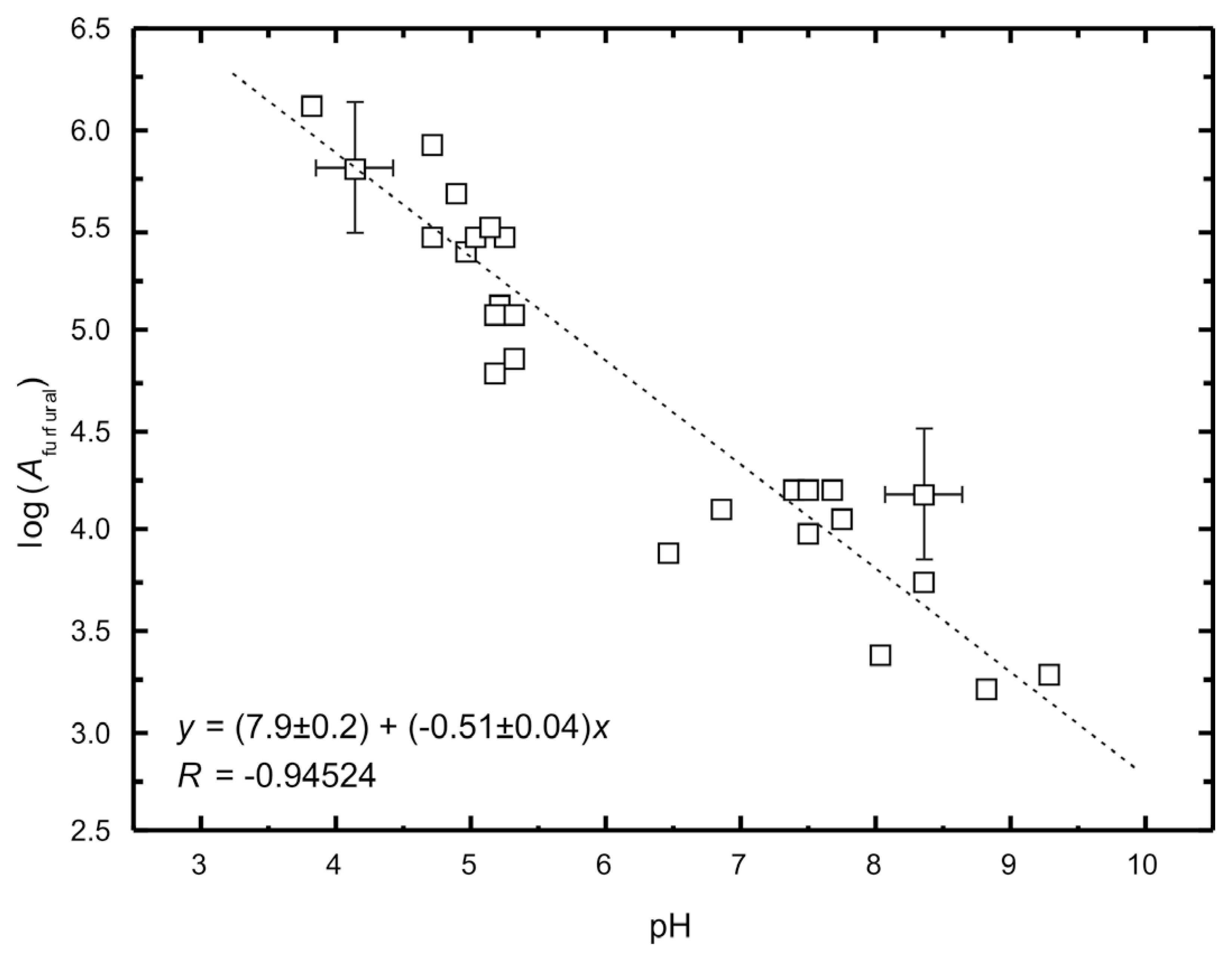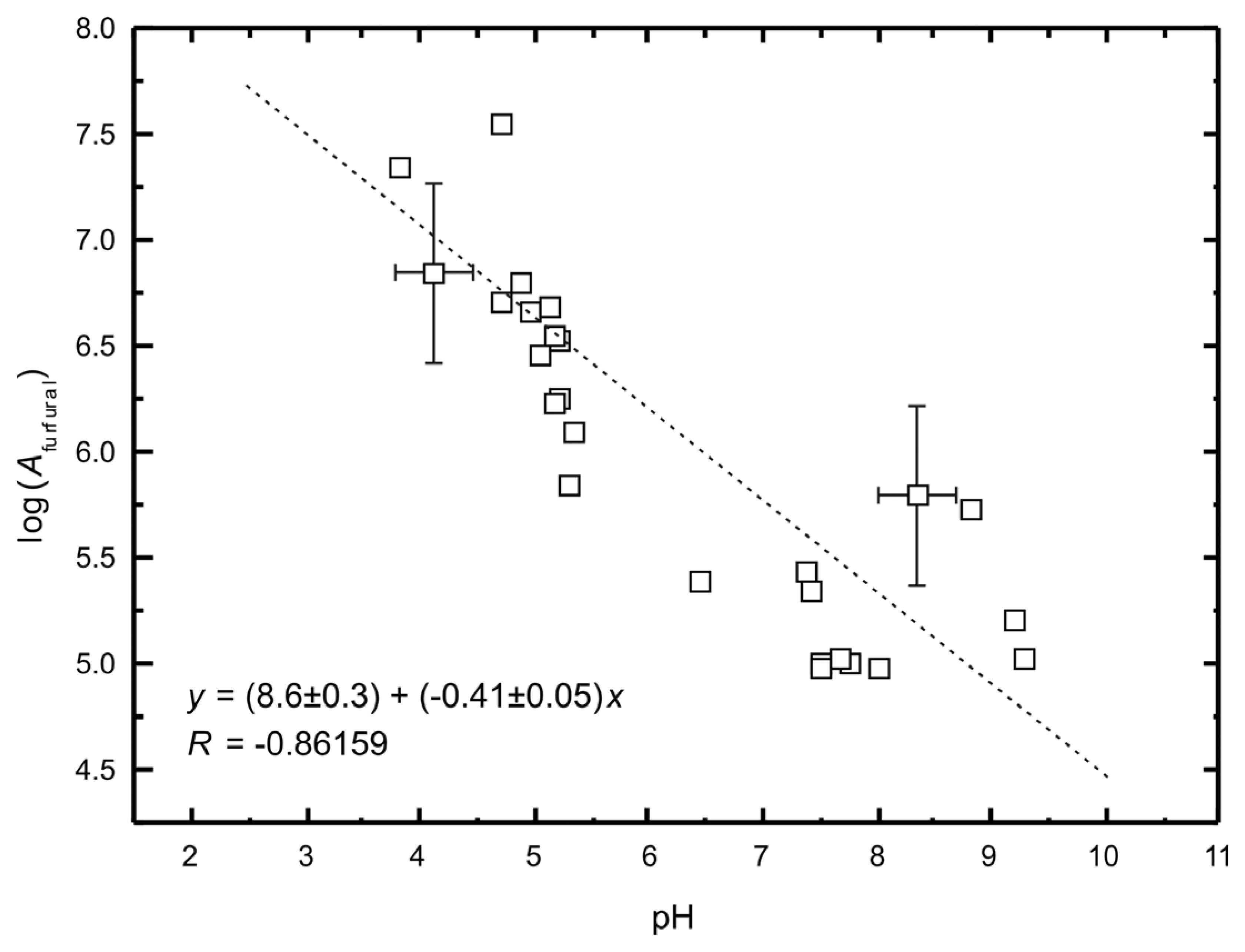Non-Destructive Evaluation of Historical Paper Based on pH Estimation from VOC Emissions
Abstract
:1. Introduction
2. Experimental Section
2.1. Samples
2.2. pH measurement
2.3. Solid-phase micro-extraction (SPME)
2.4. Static headspace sampling (SHS)
2.5. Contact sampling (CS)
2.6. Instrumentation
3. Results and Discussion
3.1. Static Headspace Sampling
3.2. Contact sampling
4. Conclusions
- —
- static headspace sampling, which is destructive and requires the sample (∼100 mg) to be heated at 80 °C for 18 h in a glass vial. After this sample preparation procedure, the VOCs are extracted using SPME,
- —
- contact sampling, which is a non-destructive procedure and requires the SPME fibre to be inserted into a paper stack for 24 h after which the GC-MS analysis is performed.
Acknowledgments
References
- Strlič, M.; Kolar, J. (Eds.) Ageing and Stabilisation of Paper; National and University Library: Ljubljana, 2005.
- Barański, A.; Konieczna-Molenda, A.; Łagan, J. M.; Proniewicz, L. M. Catastrophic Room Temperature Degradation of Cotton Cellulose. Restaurator 2003, 24, 36–45. [Google Scholar]
- Strlič, M.; Kolar, J.; Kočar, D.; Drnovšek, T.; Šelih, V.-S.; Susič, R.; Pihlar, B. What is the pH of Alkaline Paper? e-Preserv. Sci 2004, 1, 35–47. [Google Scholar]
- Strlič, M.; Pihlar, B.; Mauko, L.; Kolar, J.; Hočevar, S.; Ogorevc, B. A New Electrode for Micro-Determination of Paper pH. Restaurator 2005, 26, 159–171. [Google Scholar]
- Shafizadeh, F. Introduction to Pyrolysis of Biomass. J. Anal. Appl. Pyrolysis 1982, 3, 283–305. [Google Scholar]
- Levart, A.; Strlič, M.; Kolar, J.; Pihlar, B.; Veber, M. Determination of Volatile Cellulose Degradation Products by HPLC, IEC and CE Using Cryo-Trap Sampling, Balaton symposium on high-performance separation methods, Siófok, Hungary, Book of abstracts. September 1-3, 1999; p. P-154.
- Pawliszyn, J. New Directions in Sample Preparation for Analysis of Organic Compounds. Trends Anal. Chem. 1995, 14, 113–122. [Google Scholar]
- Prosen, H.; Zupančič-Kralj, L. Solid-Phase Microextraction. Trends Anal. Chem. 1999, 18, 272–281. [Google Scholar]
- Vas, G.; Vékey, K. Solid-Phase Microextraction: a Powerful Sample Preparation Tool Prior to Mass Spectrometric Analysis. J. Mass Spectrom. 2004, 39, 233–254. [Google Scholar]
- Lattuati-Derieux, A.; Bonnassies-Termes, S.; Lavédrine, B. Identification of volatile organic comounds emitted by a naturally aged book using solid-phase microextraction/gas chromatography/mass spectrometry. J. Chrom. A 2004, 1026, 9–18. [Google Scholar]
- Lattuati-Derieux, A.; Bonnassies-Termes, S.; Lavédrine, B. Characterisation of Compounds Emitted During Natural and Artificial Ageing of a Book. Use of Headspace-Solid-Phase Microextraction/Gas Chromatography/Mass Spectrometry. J. Cult. Herit. 2006, 7, 123–133. [Google Scholar]
- Bland, J.M.; Osbrink, W.L.A.; Cornelius, M.L.; Lax, A.R.; Vigo, C.B. Solid-Phase Microextraction for the Detection of Termite Cuticular Hydrocarbons. J. Chromatogr. A 2001, 932, 119–127. [Google Scholar]
- Godoi, A.F.L.; Van Vaeck, L.; Van Grieken, R. Use of Solid-Phase Microextraction for the Detection of Acetic Acid by Ion-Trap Gas Chromatography–Mass Spectrometry and Application to Indoor Levels in Museums. J. Chromatogr. A 2005, 1067, 331–336. [Google Scholar]
- Wenzl, T.; Lankmayr, E. Reduction of Adsorption Phenomena of Volatile Aldehydes and Aromatic Compounds for Static Headspace Analysis of Cellulose Based Packaging Materials. J. Chromatogr. A 2000, 897, 269–277. [Google Scholar]
- Nevell, T. P.; Zeronian, S. H. (Eds.) Cellulose chemistry and its applications; John Wiley: New York, 1985.
- Carter, H.; Begin, P.; Grattan, D. Migration of Volatile Compounds Through Stacked Sheet of. Paper During Accelerated Ageing. Restaurator 2000, 21, 77–84. [Google Scholar]





| Sample | Description | Composition | pH |
|---|---|---|---|
| 1 | Book, 1938 | 100% sulphite softwood pulp | 4.9 |
| 2 | Book, 1902 | 50% groundwood, 50% sulphite softwood pulp | 5.0 |
| 3 | Book, 1874 | 50% groundwood, 50% sulphite softwood pulp | 4.9 |
| 4 | Book, 1957 | 60% groundwood, 40% sulphite softwood pulp | 5.2 |
| 5 | Book, 1940 | 70% groundwood, 30% sulphite softwood pulp | 5.1 |
| 6 | Book, 1984 | 50% bleached hardwood kraft pulp, 50% bleached sulphite softwood pulp | 5.3 |
| 7 | Book, 1962 | 20% bleached hardwood kraft pulp, 80% bleached sulphite softwood pulp | 7.5 |
| 8 | Book, 1870 | 70% cotton pulp, 30% annuals (alkaline wheat straw) | 4.7 |
| 9 | Book, 1922 | 70% groundwood, 30% sulphite pulp | 4.1 |
| 10 | Book, 2002 | 70% bleached hardwood kraft pulp, 30% bleached sulphate softwood pulp. | 8.8 |
| 11 | Book, 1951 | 50% groundwood, 50% sulphite pulp | 5.2 |
| 12 | Book, 1951 | 60% groundwood, 40% sulphite pulp | 5.3 |
| 13 | Book, 1930 | 60% groundwood, 40% sulphite pulp | 4.7 |
| 14 | Book, 1960 | 50% groundwood, 50% sulphite softwood pulp | 3.8 |
| 15 | Book, 1990 | 75% groundwood, 25% bleached sulphite softwood pulp | 5.1 |
| 16 | Book, 1986 | 50% groundwood, 50% kraft pulp (softwood/hardwood = 1/1) | 5.2 |
| 17 | Newspaper, 2003 | 60% groundwood, 40% recycled fibres | 8.3 |
| 18 | Filter paper Whatman No. 1 (Maidstone, UK), 2001 | 90% cotton, 10% bleached softwood pulp | 6.4 |
| 19 | Bleached softwood sulphate pulp (Pöls, Austria), 2001 | 6.8 | |
| 20 | Cotton pulp (Radeče, Slovenia), 2001 | 100% cotton | 8.1 |
| 21 | sample 18, impregnated with Ca(HCO3)2 | 8.0 | |
| 22 | sample 19, impregnated with Ca(HCO3)2 | 8.3 | |
| 23 | sample 20, impregnated with Ca(HCO3)2 | 8.1 | |
| 24 | sample 18, impregnated with Mg(HCO3)2 | 9.3 | |
| 25 | sample 19, impregnated with Mg(HCO3)2 | 9.3 | |
| 26 | sample 20, impregnated with Mg(HCO3)2 | 9.2 | |
© 2007 by MDPI ( http://www.mdpi.org). Reproduction is permitted for noncommercial purposes.
Share and Cite
Strlič, M.; Cigić, I.K.; Kolar, J.; De Bruin, G.; Pihlar, B. Non-Destructive Evaluation of Historical Paper Based on pH Estimation from VOC Emissions. Sensors 2007, 7, 3136-3145. https://doi.org/10.3390/s7123136
Strlič M, Cigić IK, Kolar J, De Bruin G, Pihlar B. Non-Destructive Evaluation of Historical Paper Based on pH Estimation from VOC Emissions. Sensors. 2007; 7(12):3136-3145. https://doi.org/10.3390/s7123136
Chicago/Turabian StyleStrlič, Matija, Irena Kralj Cigić, Jana Kolar, Gerrit De Bruin, and Boris Pihlar. 2007. "Non-Destructive Evaluation of Historical Paper Based on pH Estimation from VOC Emissions" Sensors 7, no. 12: 3136-3145. https://doi.org/10.3390/s7123136




